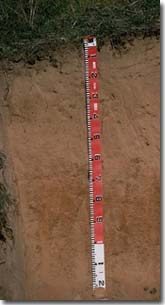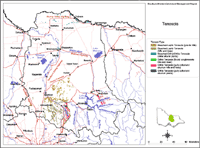Tenosols
| Tenosols have only weak soil profile development. In the Australian Soil Classification they are defined as having limited B horizon development (less than 15% clay content) but more development than the most rudimentary soils (i.e. Rudosols), including possible bleached layers and colour changes. Using the Australian Soil Classification, Tenosols can be subdivided according to surface organic matter depth and percentage, bleached layers, development of a subsoil and contact with material immediately below. These soils tend to develop on rocky areas in the uplands or on alluvial or aeolian (wind blown) deposits where soil development is weak. Tenosols have developed on granitic and acidic volcanic terrain, east and south east of Seymour and on alluvial and aeolian deposits near the Murray River. The bleached Tenosols tend to be associated with granitic parent material and are often found in association with sandy Kandosols and Chromosols. |  Bleached Tenosol developed on granite. |
| Tenosols in the Goulburn Broken Region | |
 Tenosols in the Goulburn Broken Region. |
This broad scale map presents an overview and should only be used as a general indication of the distribution of Tenosols in the Goulburn Broken Region. It shows areas where Tenosols are most likely to occur within the region. Note that other soil types may also occur within these mapped areas (although they are likely to be a more minor component). This map has been developed from work done by DPI's former Centre for Land Protection Research as part of the Goulburn Broken Dryland Regional Development Project. This work utilised existing surveys, remote sensing information and some additional field work to develop an updated 1:100 000 soil/landform coverage across the region. |
| Soils are difficult to map at this broad scale because of their diversity. Even in relatively small areas, a number of soils may occur which relate to differences in topography and landscape position. Variation in some of the major soil profile properties can also occur within these mapped areas. Any agricultural enterprise should be based on a proper on-site assessment of the soil and landscape. A number of soil surveys have been completed in this region at varying scales and intensity. However, in some areas very little soil survey has taken place (refer to the Soil and Land Survey Directory). | |

